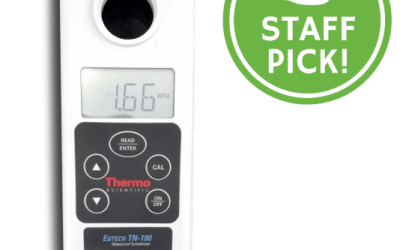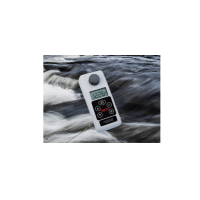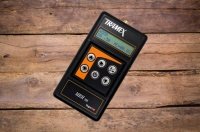Turbidity Meters; How to read specifications

Turbidity Meters measure the turbidity or the 'cloudiness' of a liquid sample. Example applications of turbidity measurements include; checking for possible contaminants in drinking water or checking various waterways to gain valuable insights into aquatic ecosystems health and condition.
To help you decipher turbidity meter specifications, the Instrument Choice Scientists have assembled a list of the most common terms and definitions you are likely to come across.
- Turbidity
Turbidity is the cloudiness or haziness of water that is caused by significant amounts of small suspended particles. Measuring the turbidity level in water is an excellent test of water quality.
- Formazine
Formazine or Formazin is a stable synthetic material that is poorly soluble in water and has a uniform particle size. For this reason, Formazine is the standard used for comparable measurements of turbidity.
- Formazine Turbidity Unit (FTU):
FTU became the defined unit of measurement after the acceptance of Formazine as the primary reference standard for turbidity. FTU, and any measurement units derived from or that reference do not specify how the turbidity instrument measures the sample. So, check the specifications of the individual unit.
- Nephelometric Turbidity Unit (NTU):
NTU signifies that the instrument is measuring scattered light from the sample at a 90-degree angle from the incident light. NTU: is a standard unit of turbidity measurement, equivalent to FTU.
- Formazine nephelometric unit (FNU):
FNU signifies that the instrument is measuring scattered light from the sample at a 90-degree angle from the incident light. FNU is generally the unit of measurement used when referencing the ISO 7027 (European) turbidity method.
- Formazine attenuation unit (FAU):
Signifies an instrument that measures the decrease in transmitted light through the sample at an angle of 180 degrees to the incident light.
- Scattered Light Measurement:
The Scattered Light Method is one of the methods utilised by turbidity meters to obtain a result.
Using the Scattered Light Method, the turbidity meter will pass light through the water sample, and as it bounces off the suspended particles, the intensity of the light beam changes. The more sediment and suspended particles in the water, the more the scattered light becomes, and therefore the more significant the impact on the lights intensity level. The meter takes this impact on the lights intensity level and converts it to a turbidity result.
- Attenuation Measurement:
This method measures the reduction in strength of light as it passes through a sample column of water. The more impacted the light source, the higher the turbidity of the sample.
- Light Source
Different standards require different light sources and, depending on the standard used in your particular industry; turbidity meters will use either infrared light at 860nm (E.g., ISO 7027) or the visible light spectrum 600-400nm (E.g., US EPA 180.1).
- ISO 7027
ISO 7027 is an International Standard specifying the technique used to determine turbidity via the concentration of suspended particles in a water sample.
- US EPA 180.1
The US EPA 180.1 is another common standard for the method of determination of turbidity by nephelometry. The technique is essentially a comparison of the intensity of light scattered by the sample under defined conditions, with the intensity of light scattered by a standard reference suspension. The higher the intensity of scattered light, the higher the turbidity.
- Calibration
Device specifications will outline the number of calibration points as well as whether or not they are user-selectable points or set points.
- Accuracy
Accuracy is the closeness of a measurement to a specific value. Specifications will express the accuracy of a device as a range, i.e., plus or minus a set amount.
- Repeatability
Repeatability is the closeness between results of successive measurements carried out under the same conditions.
- Range
The range is the scope of the values the device can measure, given as a minimum and maximum possible value.
- Response Time
Response time is the time in which it will take the meter to display and accurate and stable reading.
- Sample Volume
Sample volume refers to the amount of sample required to take an accurate measurement.
Conclusion
When searching for a turbidity meter, it's essential to understand turbidity meter specifications to select the best product for your needs and budget.
Need a bit more help with finding the perfect turbidity meter or want more terms and definitions? Contact one of the Instrument Choice Scientists. We're here to help! Call 1300 737 871 or email [email protected]
Also interesting
Turbidity Meters measure the cloudiness of a liquid sample that is caused by suspended particles. While that's simple enough, finding the right Turbidity Meter for your requirements if often (please excuse the pun) muddied by the many measurement scales associated with these devices.
To help you better understand turbidity measurement units, we have outlined the critical difference between the most common units of measurement; the Nephelometric Turbidity Unit (NTU) and the Formazin Nephelometric Unit (FNU).

Since 1974 Tramex has become an international leader in the design and production of moisture meters and scanners. Over 46 years, Tramex earned acclaim for high standards of quality and product innovation, including the invention, patent, and development of the first-ever non-destructive moisture meter.
Instrument Choice proudly recommends Tramex products and offers its cutting-edge range of meters for detecting and measuring moisture. Today we examine Tramex moisture meters and scanners by comparing the specifications and features of different models so you can select the most appropriate tool for your needs.

